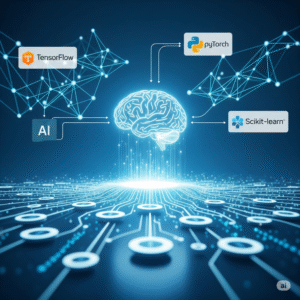We’ve all been there. Trapped in a digital maze, furiously typing “speak to a human” into a chat window that simply replies, “I’m sorry, I don’t undersWe’ve all been there. You’re trapped in a digital maze, furiously typing “speak to a human” into a chat window. In response, the bot simply replies, “I’m sorry, I don’t understand that.” Companies have shouted the promise of instant, 24/7 support through Artificial Intelligence from the rooftops. However, the reality for many customers—and for the businesses implementing these systems—is often a frustrating symphony of misunderstood queries and unresolved issues. Consequently, the revolution of AI in Customer Support is here, but it’s hitting some serious roadblocks.
While AI holds the potential to transform how businesses interact with clients and how governments deliver AI citizen services, diving in headfirst without understanding the pitfalls is a recipe for disaster. It’s not just about deploying a chatbot and watching the tickets solve themselves. In fact, the biggest challenges aren’t just technical; they are deeply human. They revolve around emotion, context, and trust. These are the three pillars of great customer service that machines are still struggling to grasp. Therefore, this article peels back the layers of hype to reveal the core challenges holding AI back. It also provides a practical roadmap for building a system that actually supports your customers, instead of alienating them.
The Unspoken Challenges of AI in Customer Support
The initial appeal of AI is undeniable. It promises cost reduction, scalability, and round-the-clock availability. As a result, businesses see a chance to handle thousands of queries simultaneously without scaling their human workforce. However, this efficiency-first approach often overlooks the nuanced reality of human interaction. This oversight leads to significant, often unspoken, challenges that can damage brand reputation and customer loyalty.
Challenge 1: The Lack of Genuine Empathy and Emotional Intelligence
First and foremost, the number one rule of customer support is to make the customer feel heard and understood. This is especially true when they are frustrated or upset. While a programmer can teach an AI to recognize keywords like “angry” and respond with a scripted apology, it cannot replicate genuine empathy. The AI simply doesn’t understand the why behind the frustration. For instance, it can’t sense the subtle shift in tone from slightly annoyed to completely fed up. This emotional void is where many AI systems fail catastrophically.
A customer whose long-awaited package arrived damaged isn’t just looking for a refund link. They are also looking for acknowledgement of their disappointment. A generic “I understand this is frustrating. Here is our returns policy” feels cold and dismissive. This is a critical challenge for AI in Customer Support. Ultimately, a lack of emotional intelligence can turn a solvable problem into a lost customer. True connection requires more than just processing words; it requires understanding emotion.
Challenge 2: The ‘I Don’t Understand’ Loop: Contextual Blindness in Chatbots for Helpdesk
Another common complaint about chatbots for helpdesk is their inability to understand context or handle complex queries. For example, an AI might be trained to answer “What are your business hours?” perfectly. But what if the query is, “I need to know your hours for today, but also if you’ll be open on the upcoming public holiday and whether I can pick up an online order then?” This multi-layered question often short-circuits a basic chatbot.
This “contextual blindness” forces the customer to break down their query into unnaturally simple parts. Unfortunately, this process is both inefficient and irritating. The infamous “I don’t understand” response loop begins, and the customer’s initial patience quickly evaporates. Without the ability to remember previous parts of the conversation or grasp intent, the AI becomes less of a helper and more of an obstacle. This completely undermines the very purpose of its existence. As a resource from OpenAI highlights, while models are becoming more conversational, maintaining context over long interactions remains a developmental frontier.
Integrating AI in Customer Support: The Technical and Data Hurdles
Beyond the user-facing issues of empathy and context lies a web of technical challenges. A successful AI in Customer Support system doesn’t operate in a vacuum. Instead, it must weave into the very fabric of the business’s technology stack. Furthermore, its intelligence depends entirely on the quality of the data it consumes.
Challenge 3: The Data Dilemma: Garbage In, Garbage Out
An AI is only as smart as the data it learns from. If you train your customer support AI on a dataset of incomplete or biased conversation logs, it will deliver incomplete or biased support. This “garbage in, garbage out” principle is a fundamental challenge. The reality is that many businesses lack clean, well-organized data. Their historical support tickets might be filled with slang, typos, or shorthand that an AI can’t easily parse.
Moreover, the AI needs continuous updates with new information about products, policies, and customer issues. A static AI becomes dumber by the day in a dynamic business. The process of collecting, cleaning, and continuously feeding high-quality data to the AI model is a massive, resource-intensive undertaking that many companies unfortunately underestimate.
Case Study 1: Zenith Electronics’ Integration Wake-Up Call
Zenith Electronics, a mid-sized e-commerce retailer, deployed a new chatbot to handle order status inquiries. They trained it on thousands of past email logs but quickly faced a surge in customer complaints. The chatbot couldn’t distinguish between “shipped” and “out for delivery” because their internal CRM used inconsistent terms. Consequently, it was pulling outdated data, telling customers their order was “processing” when it had already arrived.
The solution was a two-pronged attack. First, they used a data integration tool to standardize the language between their CRM and the chatbot’s knowledge base. Second, they implemented a workflow using a platform like Zapier to create real-time triggers. Now, when an order status changes in their shipping software, Zapier instantly pushes that update to the AI. As a result, Zenith saw a 70% reduction in “where is my order?” escalations and a marked improvement in customer satisfaction.
Challenge 4: Seamless Integration is a Myth (For Now)
A truly effective AI support system needs to do more than just talk; it needs to do things. It should be able to check a customer’s order history, process a refund, or check inventory levels. This requires deep and complex integrations with multiple backend systems. The problem is, many businesses operate on a patchwork of legacy and modern software. Getting them all to communicate with an AI is a significant technical challenge.
Without these integrations, the AI’s usefulness is severely limited. It can answer basic FAQs but must hand off any action-oriented request to a human agent. This creates a clunky and disjointed customer experience. This is also a major hurdle for organizations aiming to provide efficient AI citizen services, where integration with diverse government databases is essential.
A Practical Guide to Implementing AI in Customer Support Successfully
Therefore, overcoming these challenges doesn’t mean abandoning AI. It means being smarter and more strategic about its implementation. A human-centric approach, where AI augments rather than replaces, is the key to success.
Start Small: A Beginner’s Workflow
Instead of trying to automate everything at once, start with a focused, manageable approach.
- Identify the Biggest Pain Points: First, start with the problem, not the AI. Use your support data to find the top 3-5 most common, repetitive questions your team answers daily. These are your prime candidates for automation.
- Choose the Right Tool: Next, don’t just grab the most popular chatbot. Do you need a simple FAQ bot or a sophisticated conversational AI? Tools like ChatGPT are powerful for generating human-like text, but a dedicated platform might offer better integrations.
- Run a Pilot Program: Then, deploy the AI on a single channel and clearly label it as a bot. Focus on answering only the specific questions you identified in step one.
- Create a Seamless Handoff: This is the most crucial step. Design a clear and easy pathway for the customer to connect with a human agent at any point. Remember, the goal is assistance, not containment.
- Analyze and Iterate: Finally, use the AI’s interaction logs to see where it’s succeeding and failing. Use this data to improve its responses and expand its capabilities gradually.
Essential AI Tools to Overcome Support Challenges
- For Understanding Customer Sentiment: A tool like MonkeyLearn uses AI to perform sentiment analysis on incoming messages. It can automatically tag inquiries from frustrated customers and escalate them to a human, directly tackling the “empathy” challenge.
- For Data-Driven Decisions: Platforms like Tableau or Microsoft Power BI are not just for sales. You can connect them to your helpdesk to visualize AI performance. This allows you to see which questions your bot answers most, where it fails, and how it impacts agent workload. In short, it helps you refine your AI strategy.
- For Building Smarter Conversations: While building from scratch is complex, leveraging the power of large language models via APIs is becoming easier. For example, the API for ChatGPT allows developers to build sophisticated conversational agents that have a better grasp of context.
Case Study 2: FinSecure Bank Builds Trust with a Hybrid Model
FinSecure Bank wanted to use AI to improve its digital service offerings, a form of AI citizen services for their client base. Aware of the immense security challenges, they avoided a fully automated approach. Instead, they implemented an AI-powered triage system. Now, when a customer initiates a chat, the bot handles initial verification and categorizes the issue (e.g., “balance inquiry,” “report fraud”).
For simple, non-sensitive queries, the AI provides an instant answer. For anything involving account details, however, the AI seamlessly transfers the chat to a specialized human agent. This “human-in-the-loop” model reduced wait times by 40% while ensuring a trusted professional handled sensitive matters. The AI acts as an efficient receptionist, not the final advisor. This approach, as detailed in reports by firms like McKinsey, is proving to be a highly effective strategy.
The Future of AI in Customer Support and AI Citizen Services
The road for AI in Customer Support is bumpy, but the destination is promising. The future isn’t a world without human support agents. On the contrary, it’s a world where AI empowers human agents. The machine will handle the repetitive, data-retrieval tasks like checking order statuses or answering FAQs. This, in turn, frees up human agents to focus on what they do best: solving complex problems, building relationships, and providing genuine empathy.
This same principle applies to the growing field of AI citizen services. An AI can help a citizen find the right government form or check a permit status. However, a human will always be needed to navigate the complex, personal issues that arise. The goal is to create a hybrid system where efficiency and empathy coexist.
In conclusion, the biggest challenge of AI in Customer Support is not the technology itself, but our approach to it. By seeing AI as a powerful tool to assist, not a cheap replacement to eliminate, we can build better support systems. The businesses that succeed will be the ones that master this delicate balance, ultimately turning potential pitfalls into a powerful competitive advantage.
AI in Customer Support, chatbots for helpdesk, AI citizen services, challenges of AI in customer service, AI customer support benefits, AI customer experience, customer service automation, AI chatbot implementation, future of customer support, conversational AI for support, AI-powered helpdesk, AI for business, implementing AI in business.
No More Lines? AI Is Killing Government Bureaucracy
Can AI Stop the Next Disaster? The Tech That’s Changing Everything



